Seeing bird nests attached to buildings, specifically on the sides or under eaves from late spring to early summer? Those are probably cliff swallows and they can become an even bigger problem if they build colonies. Getting rid of them should be your top priority!
So, how to get rid of cliff swallows? You can use the following methods: nest removal, bird barriers, sound deterrents, liquid bird repellent sprays, and Bird Flite bird control spikes. For better and more effective results, employ two or more of these methods simultaneously.
If you want to know more about cliff swallows, how to properly identify them, telltale signs of infestation, and how to get rid of them accordingly, read further this article!
What Are Cliff Swallows?
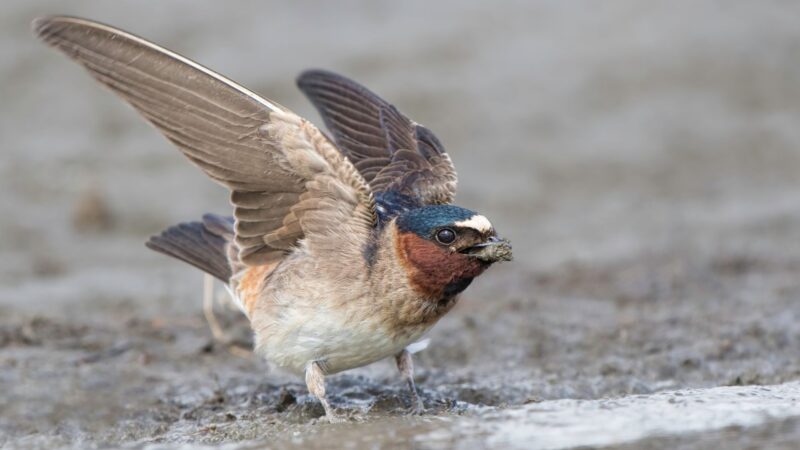
Identification and Biology
Named after their preferred breeding site, Cliff swallows (Petrochelidon pyrrhonota) are characterized by their compact bodies, broad and rounded wings, and squared tails. They have an overall brown or chestnut plumage, dark and metallic upperparts, whitish chest, and a distinctive white triangular-shaped patch on the forehead.
Cliff swallows weigh an average of up to 24 grams and are up to 15.24 centimeters in length. Compared to other swallows in North America, they have thicker heads and necks. Additionally, they are diurnal, migratory, highly social, and known to be speedy but efficient fliers.
Habitat
Cliff swallows inhabit valleys, canyons, cliff faces, and hills but are also prevalent in buildings or bridges that were man-made. As such, you can also see them in towns, marshes, and grasslands. These nesting sites are usually near bodies of water.
Site Selection
Factors that cliff swallows consider when choosing a site to nest in are easy access to water for drinking, an abundance of food, a vertical surface where they can hang or attach the nest, and availability, and supply of mud and other nesting materials.
These birds will typically nest near other large colonies as they perform brood parasitism or, in other words, produce and lay eggs on the nests of neighboring birds.
Nest Construction
Accumulating and using mud of the right consistency, these birds will build nests and mold them into a dome shape. They also incorporate feathers, grasses, and other materials that are able to circulate heat and provide a safety net for their eggs.
Related: How to Keep Birds From Nesting on Porch? | The Effective Guide
How to Know If You Have Cliff Swallows Infestation?
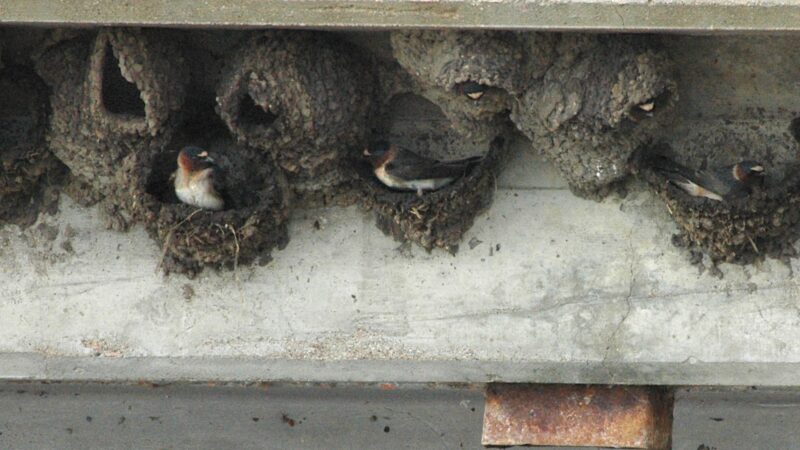
Telltale signs that you are currently having an infestation of cliff swallows are the appearance of mud droppings and a sudden increase in the number of birds or their activity around your vicinity. Additionally, if there are more flying insects than usual invading the outside of your home, there may be cliff swallows nearby.
Related: How to Get Rid of Cowbirds | An Effective Guide
How to Get Rid of Cliff Swallows?
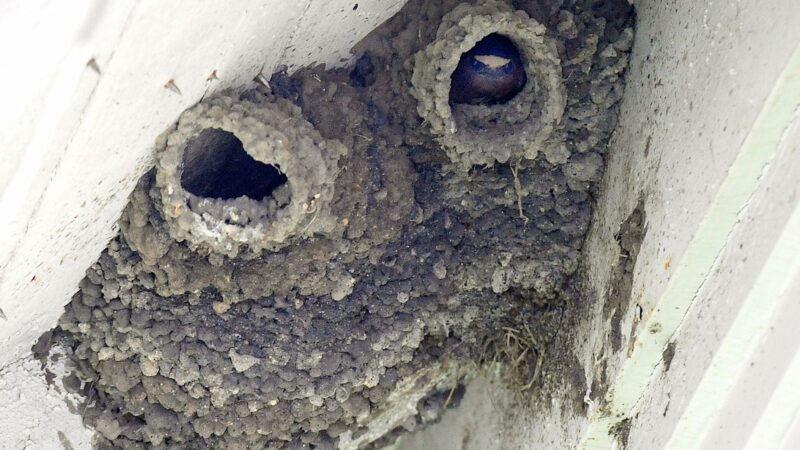
1. Nest Removal
First, make sure that the breeding season for cliff swallows is over. Nest removal during this period is illegal as the birds are protected by the Migratory Bird Treaty Act and is considered cruel since there may be eggs or nestlings involved.
Prior to removal, wear personal protective clothing and equipment since the nests are unsanitary and may pose health hazards. To remove any existing cliff swallow nest in your property, use a power-washer, garden hose, or mud scraper to break up the materials making the nest.
Afterward, cliff swallows are prone to re-nesting, especially if the nests only need a little repairing and restoring. As such, after successful removal, clean and sanitize the area thoroughly so that they would have no nests to come back to.
Related: How to Prevent Birds Nesting in Roof? | Information and Control Guide
2. Establish Bird Barriers
These bird deterrents are usually made out of wire, nylon, mesh or a combination of these netting materials, and should be placed in existing or potential nesting and landing sites. Choose a heavy-duty, long-lasting product and make sure they look unnoticeable to birds.
Here are some good quality products you can try out:
- Bird Netting: The size of the anti-bird net is 13*33ft,and the...
- Easy to cut:The garden netting is large enough that you can cut...
- Durable: The garden net is made of high quality polyethylene...
- Protection: With this netting for garden protection, you don't...
- Wide range of uses: Can be used as poultry nets and anti-bird...
- Bird Netting for Chicken Coop: Cover your chicken run, chicken...
- Bird Netting for Garden: Whether you're growing blueberries,...
- Material & Durability: Made from high-quality HDPE material using...
- Multi-purpose: Simply cover your plants, fruit trees, vegetables,...
- Notice: The chicken mesh netting can be cut to any size you need...
3. Sound Deterrents
Auditory bird repellents can also be used to frighten cliff swallows from entering your property. Examples would be ultrasonic sound devices that emit high-frequency waves that irritate birds and predator or bird distress recordings. Strategically place them in existing or potential nesting areas.
- Long Term Use: Continuous use of the ultrasonic bird repeller for...
- New Version Upgrade in 2025: The solar ultrasonic bird repeller...
- Solar Fast Charging: We have equipped a solar charging board on...
- Waterproof Ultrasonic Animal Repellent Outdoor: Solar ultrasonic...
- Come and use it! If you are tired of stray animals disrupting...
- ✔️Long Term Use: Different animals, even within the same...
- ✔️2026 New: The animal repellent has increased the working...
- ✔️Solar Fast Charging: We have equipped a solar charging...
- ✔️Waterproof Ultrasonic Animal Deterrent: Solar ultrasonic...
- ✔️Come and use it! : If you are tired of stray animals...
4. Liquid Bird Repellent Sprays
Bird deterrent sprays are formulated with non-toxic ingredients that are irritating to the birds and are easy to apply in areas where they nest or can potentially nest. These products come in a liquid form and can successfully deter cliff swallows.
Related: How to Get Rid of Myna Birds | Essential Tactics to Follow!
5. Apply Bird Flite Bird Control Spikes
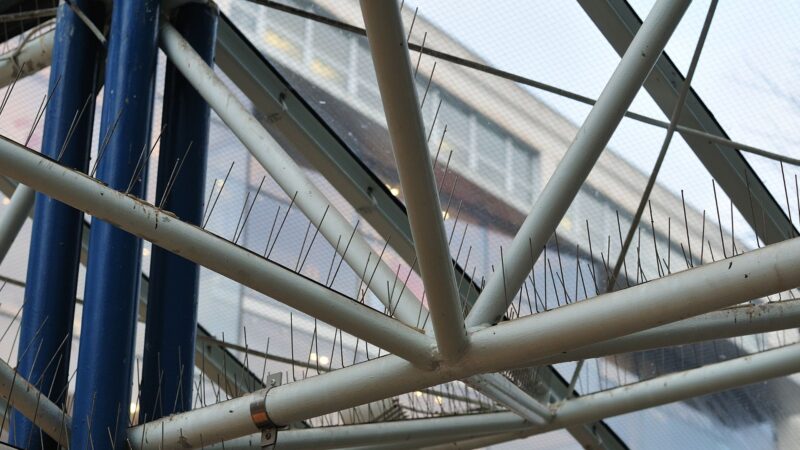
This product is made of durable stainless steel and polycarbonates designed to be a subtle method of discouraging cliff swallows. It comes in three varying widths and is installed to a pipe, ledge, beam, and other surfaces on which the birds can build nests on. Installation only takes a few minutes but it depends on how long the nesting area is.
Related: American Coot Control | Best Strategies for Effective Management
How to Prevent Cliff Swallow Infestation?
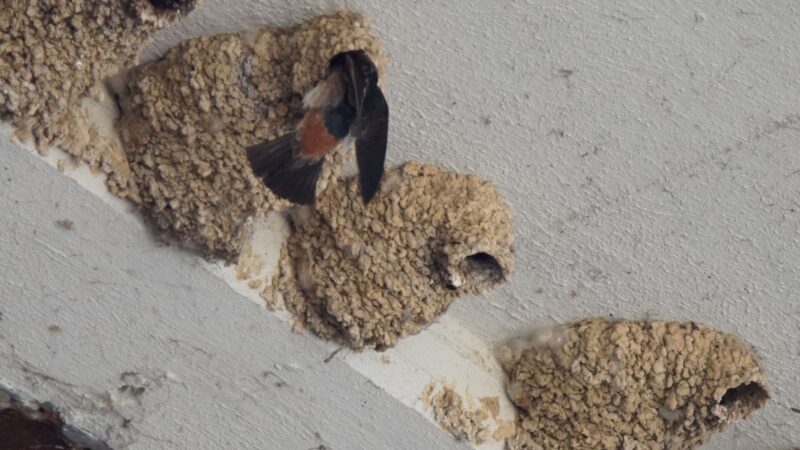
The best preventive measure against infestations of cliff swallows is to significantly decrease the attractiveness of your property. Additionally, the following methods are also helpful:
- Perform regular assessments of your property to discern if there are any signs of cliff swallow activity. If there are, address them right away or else they will become a bigger problem.
- Keep outdoor areas clean and well-sanitized. Dispose of any trash that can become a potential hiding place for insects which can, in turn, attract the birds.
- If you have the time, money, and effort to do so, create alternative nesting areas for the birds by constructing birdhouses or nest cups. Make sure to install them away from your property so that they do not become a nuisance to you.
- Consider planting trees and shrubs, also away from your home, to provide more means of shelter and nesting for cliff swallows.
Related: How to Prevent Birds Nesting in Roof? | Information and Control Guide
Key Takeaways
Now that you’ve reached the end of the article, it’s time to start being proactive to prevent cliff swallows from entering and nesting on your property. Aside from the five main ways of getting rid of them, it is also important to keep the place as unattractive for them as possible by cleaning, and providing alternative sites for nesting, or planting.
List of Sources
- All About Birds. (n.d.). Cliff Swallow.
- Brown, C. R., & Brown, M. B. (1995). Cliff Swallow (Petrochelidon pyrrhonota).
- Oregon State University. (n.d.). How do I discourage birds from nesting?
- Swaddle, J. P., & Callaway, E. S. (2015). What can birds tell us about the migration decisions of pestiferous insects?
- Tulppo, J. (n.d.). Petrochelidon pyrrhonota: cliff swallow.
- U.S. Fish & Wildlife Service. (n.d.). Nuisance swallows.
- University of California – Statewide Integrated Pest Management Program. (n.d.). Cliff Swallows.
- How to Get Rid of Copperheads | Practical Guide - August 27, 2023
- How to Get Rid of Corn Snakes | What Makes Them Aggressive? - August 27, 2023
- How to Get Rid of Alligators | Safety Measures and Removal Methods - July 16, 2023




